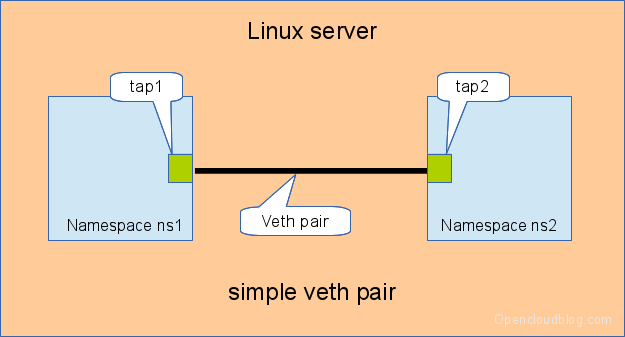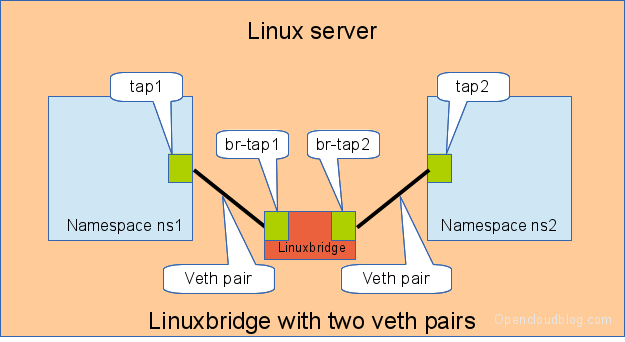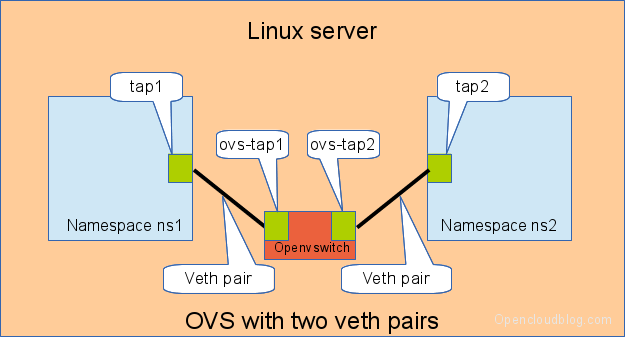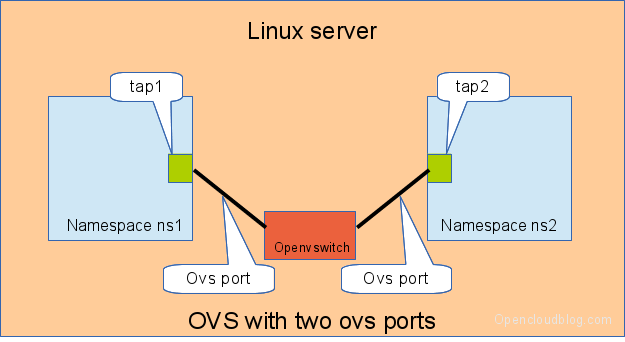http://www.opencloudblog.com/?p=66
Switching in software on Linux is one of the important parts when using virtualization technologies like KVM or LXC. Typical hosts do not provide one or more physical adapters for each NIC of a virtual machine in KVM or per container when using LXC. Something
else must take the part to interconnect the virtual network interfaces.
The software switching classical tool is the linuxbridge, which is available in the Linux kernel for a long time. The frontend to manage the linuxbridge is
brctl. The newer tool is the Openvswitch (at http://openvswitch.org/). The main frontend is
ovs-vsctl.
In this post I will show multiple solutions to interconnect Linux namespaces using a software based switch. A performance analysis of these solutions will be discussed in another article later. Starting with network namespaces helps to understand the more
complex situations when using KVM or LXC.
tap interfaces
Linux tap interfaces created with ip tuntap cannot be used to attach network namespaces to linuxbridges or the openvswitch.
veth pair
The simple solution to connect two network namespaces is the usage of one veth pair. This has been discussed in a previous artice.

Connecting namespaces using a veth pair
The command sequence has been discussed in a previous article, but we show the commands here again
1
2
3
4
5
6
7
8
9
10
11
12
|
# add the namespaces
ip netns add
ns1
ip
netns add ns2
# create the veth pair
ip
link add
tap1 type
veth peer name
tap2
# move the interfaces to the namespaces
ip
link set
tap1 netns ns1
ip link
set tap2 netns
ns2
# bring up the links
ip netns exec
ns1 ip link
set dev tap1
up
ip
netns exec ns2
ip link
set dev tap2
up
# now assign the ip addresses
|
linux bridge and two veth pairs
When more than two network namespaces (or KVM or LXC instances) must be connected a switch should be used. Linux offers as one solution the well known linux bridge.

Connecting namespaces using a linux bridge and two veth pairs
We need for this setup one switch, and two connectors. In this setup we use a linuxbridge and two veth pairs.
The commands to create this setup are:
1
2
3
4
5
6
7
8
9
10
11
12
13
14
15
16
17
18
19
20
21
22
23
24
25
26
27
28
29
30
31
|
# add the namespaces
ip netns add
ns1
ip
netns add ns2
# create the switch
BRIDGE=br-test
brctl addbr
$BRIDGE
brctl
stp $BRIDGE
off
ip link
set dev
$BRIDGE up
#
#### PORT 1
# create a port pair
ip link
add tap1 type
veth peer name
br-tap1
# attach one side to linuxbridge
brctl addif br-test
br-tap1
# attach the other side to namespace
ip link
set tap1 netns
ns1
# set the ports to up
ip netns exec
ns1 ip link
set dev tap1
up
ip
link set
dev br-tap1
up
#
#### PORT 2
# create a port pair
ip
link add
tap2 type
veth peer name
br-tap2
# attach one side to linuxbridge
brctl
addif br-test
br-tap2
# attach the other side to namespace
ip
link set
tap2 netns ns2
# set the ports to up
ip
netns exec ns2
ip link
set dev tap2
up
ip link
set dev br-tap2
up
#
|
openvswitch and two veth pairs
Another solution is to use the openvswitch instead of the „old“ linuxbrige. The configuration is nearly the same as for the linuxbridge.

Connecting namespaces using the openvswitch and two veth pairs
We need for this setup one switch, and two connectors. In this setup we use an openvswitch and two veth pairs.
The commands to create this setup are:
1
2
3
4
5
6
7
8
9
10
11
12
13
14
15
16
17
18
19
20
21
22
23
24
25
26
27
28
29
|
# add the namespaces
ip netns add
ns1
ip
netns add ns2
# create the switch
BRIDGE=ovs-test
ovs-vsctl
add-br
$BRIDGE
#
#### PORT 1
# create a port pair
ip link
add tap1 type
veth peer name
ovs-tap1
# attach one side to ovs
ovs-vsctl
add-port
$BRIDGE ovs-tap1
# attach the other side to namespace
ip link
set tap1 netns
ns1
# set the ports to up
ip netns exec
ns1 ip link
set dev tap1
up
ip
link set
dev ovs-tap1
up
#
#### PORT 2
# create a port pair
ip
link add
tap2 type
veth peer name
ovs-tap2
# attach one side to ovs
ovs-vsctl
add-port
$BRIDGE ovs-tap2
# attach the other side to namespace
ip
link set
tap2 netns ns2
# set the ports to up
ip
netns exec ns2
ip link
set dev tap2
up
ip link
set dev ovs-tap2
up
#
|
openvswitch and two openvswitch ports
Another solution is to use the openvswitch and make use of the openvswitch internal ports. This avoids the usage of the veth pairs, which must be used in all other solutions.

Connecting namespaces using the openvswitch and two openvswitch ports
We need for this setup one switch, and two connectors. In this setup we use an openvswitch and two openvswitch ports.
The commands to create this setup are:
1
2
3
4
5
6
7
8
9
10
11
12
13
14
15
16
17
18
19
20
21
22
|
# add the namespaces
ip netns add
ns1
ip
netns add ns2
# create the switch
BRIDGE=ovs-test
ovs-vsctl
add-br
$BRIDGE
#
#### PORT 1
# create an internal ovs port
ovs-vsctl
add-port
$BRIDGE tap1
-- set
Interface tap1
type=internal
# attach it to namespace
ip link
set tap1 netns
ns1
# set the ports to up
ip netns exec
ns1 ip link
set dev tap1
up
#
#### PORT 2
# create an internal ovs port
ovs-vsctl
add-port
$BRIDGE tap2
-- set
Interface tap2
type=internal
# attach it to namespace
ip link
set tap2 netns
ns2
# set the ports to up
ip netns exec
ns2 ip link
set dev tap2
up
|
Performance
In another article I will show some performance numbers for the four presented solutions. There are noticeable differences with respect to throughput and CPU usage.



